Essex
Despite its modern reputation, Essex in the seventeenth century was a centre for Puritan belief and practice. There are memories of the Pilgrim Fathers, and of two scholarly men who followed them to New England within a few years - Thomas Hooker and John Eliot. Two centuries later, Puritan teaching sprang to life again in the person of Charles Haddon Spurgeon, whose father and grandfather were both pastors of Independent congregations in Essex. Spurgeon himself was born, brought up and converted within the county. His gifts as a preacher took him first to Cambridge then to London, where no church could hold the crowds he attracted.
COLCHESTER
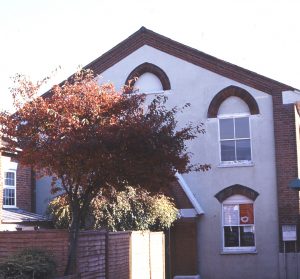
Artillery Street Chapel
In the nineteenth century, the area to the south of the town centre was developed as a military garrison. Streets with names like Military Road, Barrack Street and Cannon Street criss-cross the area. It was at a small chapel in Artillery Street (CO1 2EW) just off Barrack Street that the teenage Charles Spurgeon (1834-1892) was converted on 6th January 1850. Spurgeon was living with his parents on Hythe Hill and had set off on a bitterly cold morning to walk to church in the town centre. As the weather grew worse, he abandoned his plans and turned down Artillery Street to a Primitive Methodist chapel for shelter. There were few present and the local lay preacher considered cancelling the service. He decided to continue and preached on the text Look unto me and be saved all you ends of the earth.
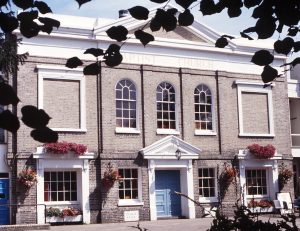
Eld Lane Chapel
Despite the influence of his father and grandfather, both ministers, Spurgeon had not yet made a personal step of faith, but the exhortation of the uneducated layman to "Look and be saved" was the climax of his spiritual search. Later the same day, Spurgeon attended Eld Lane Baptist Church (CO1 1LLS) near the town centre with his mother. This time the text was Accepted in the beloved which served to confirm his commitment.
The chapel in Artillery Street dates from the early nineteenth century. The facade, with brick arches over the windows and a pointed brick porch, shows the simplicity and symmetry of the period but is partly obscured by the garden fence of a neighbouring house. Inside a marble tablet tells the story of Spurgeon's conversion in his own words.
In Maidenburgh Street, close to the Castle, is the modern Castle Methodist Church, built on the site of the first Methodist chapel in Essex, opened by John Wesley in 1759. For a time Francis Asbury, Wesley's first missionary to America, had a house here. In the same street is St Helen's Chapel, recalling the legend that St Helen, mother of the emperor Constantine (d.337), lived here and that her son, the first Christian emperor, was born in Colchester. The chapel, restored in the nineteenth century and now used by the Greek Orthodox Church, has Roman foundations and the structure incorporates Roman bricks and tiles.
KELVEDON
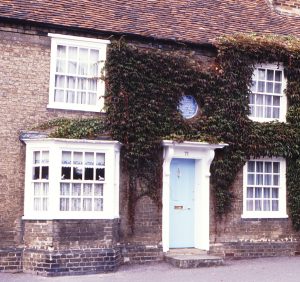
Spurgeon's birthplace
Charles Spurgeon was born at 71 High Street (CO5 9AE) on the 19th June 1834. The house is privately owned and is part of a terrace of grey stone cottages. The front, formerly covered by a prolific Virginia creeper, displays a blue plaque describing Spurgeon as Baptist preacher and philanthropist.
At the time of his birth, Spurgeon's father John Spurgeon was pastor of a congregational church at Tollesbury, some ten miles away. Spurgeon only lived at Kelvedon for the first year of his life. For some reason, perhaps financial, he was sent at the age of eighteen months to live with his grandfather James Spurgeon at Stambourne. Here he began to absorb the puritan tradition of his ancestors and his extraordinary gifts led him as a preacher first to Cambridge and then to London while still in his teens.
STAMBOURNE
Towards the western end of this straggling village deep in the Essex countryside is a red brick chapel, next door to a house called the Old Manse. It was here that the young Charles Spurgeon, barely more than a baby, came to live with his grandparents, the Rev. James Spurgeon and his wife Sarah. He remained for about six years. Despite his youth, the precocious Charles was already beginning to imbibe the teachings of his grandfather. Taught to read by a favourite aunt, he began to explore a library of theological works that he discovered in an attic room.
Both church and manse are new since Spurgeon's time. The single storey chapel (CO9 4NX), small and plain, probably dates from the 1950s, but bears a resemblance to pictures of the old Meeting House. The manse, now a private house, was rebuilt in Victorian times but may incorporate parts of the building that Spurgeon knew. The Spurgeon grandparents are buried in the churchyard but the headstone is in poor condition and hard to read.
GREAT BURSTEAD
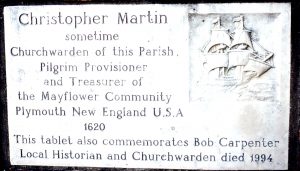
Mayflower memorial
A plaque on the inside of the churchyard wall (CM11 2TR) just to the right of the entrance commemorates a recent church warden, and also one his predecessors nearly 400 years earlier. This was Christopher Martin, who served as treasurer and governor of the Mayflower community. When the Pilgrim Fathers were exiled at Leyden in Holland, they sought a man as their agent in preparing for the voyage to New England. Martin was a successful businessman in Billericay and churchwarden here in 1611. He sailed on the historic Mayflower voyage, together with his wife Marie, stepson Solomon Prowe and servant John Langemore. It seems that Martin may have been more interested in the commercial opportunities of the New World than in the spiritual convictions of the Pilgrims. He was deposed as leader of the community in favour of William Bradford, and his whole family group perished in the first winter of 1620-21.
BILLERICAY
The town is proud of its links with the Mayflower story and many businesses and buildings have the name Mayflower or Pilgrim in their title. In Chapel Street, the graveyard of the United Reformed Church faces the Mayflower Hall. Inside there is a tablet commemorating Christopher Martin and his family group. All four died during the first winter on board ship, lying off the coast of Massachusetts. Martin is believed to have owned the buildings now forming 57 to 61 High Street (CM12 9AX), and to have met here on the night before he joined the ship. When we last visited, they were in use as a bookshop and an Indian Restaurant, with the date 1501 on the outside.
HARWICH
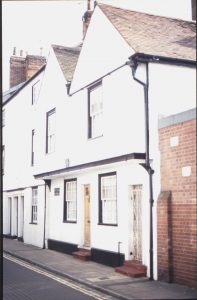
Christopher Jones house, Harwich
Harwich lies on the south side of the estuary where the rivers Stour and Orwell flow into the North Sea and looks across to the vast container port at Felixtowe. It has a maritime history going back many centuries and ferries depart daily for Scandinavia and the Continent from the busy Parkeston Quay terminal. At the centre of the town is a network of streets adjoining the quayside, where ancient houses, shops and pubs have survived remarkably unscathed. A Maritime Heritage Trail guides us round places of interest, among which is the house of Christopher Jones, captain of the Mayflower which took the Pilgrim Fathers to New England in 1620.
The house, actually 21 Kings Head Street (CO12 3EE), with its white-painted double gable overhanging the street, is still privately owned. Jones was married twice, both at nearby St Nicholas Church, although the present church building is later. In a wooden building on the pier, there is a small exhibition, open in the summer months telling the story of the Mayflower Pilgrims.
Another maritime connection with the early history of America is mentioned on a plaque on the wall of Quayside court. Christopher Newport, commander of the expedition that established the colony of Jamestown in 1607, was born in the town and baptised in St Nicholas Church in 1561. Quite an impressive record for one small seaport!
LITTLE BADDOW

Cuckoo's Farm
There are links with two famous Puritans who left these shores for New England a few years after the Pilgrim Fathers, but first we have to find the place in a maze of lanes deep in the Essex countryside.
West of the village, where Colam Lane meets Holybread Lane is a delightful half-timbered house called Cuckoo's Farm,close to the Baptist chapel (CM3 4BN), complete with duck pond and orchard. It was here that Thomas Hooker (1586-1647) and John Eliot (1604-1690) started a school in about 1626. The house can be viewed from the road but is privately owned. It carries a blue plaque stating that Thomas Hooker, Father of American Democracy, and John Eliot, Apostle of the Indians, lived here from 1626 to 1631.
Eliot departed for America in 1631 in the ship Lyon. In 1632, he became pastor of a church at Roxbury, Massachusetts, where he remained for almost sixty years. He compiled a Psalter, believed to be the first book ever printed in America. His ministry was marked by heroic attempts to reach out to native tribes, which achieved considerable success. He learned to speak the Algonquian language and even reduced it to writing in order to translate the Bible. Sadly, much of his work was later undone by disputes and wars between the tribes and European settlers.
Hooker had been ordained in the Church of England and during his time here held a lectureship at Chelmsford. His Puritan views had already attracted the unwelcome attention of Archbishop Laud. He left for Holland in 1630 and three years later set sail for America in the Griffin. He pastored a church in Massachusetts and later moved with his congregation to Hartford, Connecticut. He was a man of considerable intellect and became identified with all the important religious and political movements in Massachusetts.
BRADWELL ON SEA
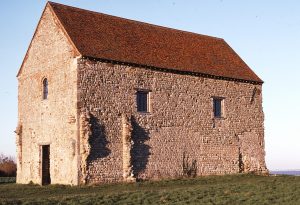
Saxon Chapel, Bradwell
Bradwell lies on the south side of the Blackwater estuary, through a maze of winding country roads east of Chelmsford. Our goal is the ancient Saxon chapel of St Peter-on-the-Wall (CM0 4PN). In the village, turn right at the King's Head pub into East End Road. About two miles down here is a car park, and the last half mile is covered on foot. The chapel stands almost directly on the shore, with nothing but the North Sea beyond. It claims to be the oldest church in England, but not without stiff competition from other contenders.
In 653, St Cedd arrived by boat from Lindisfarne with one companion and built the chapel as the focus of a thriving Christian community. From here he extended his mission to other areas of Essex including Greensted, where the famous log church was built later.
Built of stone and tiles gathered from a lost Roman fort, the chapel rises above the Essex marshes, plain, dignified and resilient, as befitting the lives of those early Saxon saints. It was formerly used as a cowshed and only restored in the 1920s. Odd buttresses outside suggest the chapel was part of a larger building and inside there is an artist's impression of the original. It makes no particular effort to tap into the tourist trade, but still attracts a steady stream of visitors. The inside is virtually unfurnished, but is used occasionally for services and cultural activities. An incongruous reminder of the twentieth century lies about a mile to the north - Bradwell nuclear power station.
GREENSTED
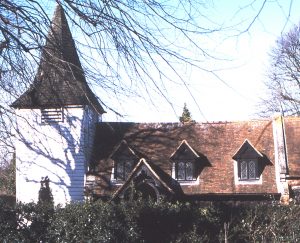
Greensted Saxon church
This tiny hamlet lies just west of Chipping Ongar. In a pleasant wooded glade, set back from the road, is the ancient log church of St Andrew's (CN5 9LD) with its weather-boarded tower and shingled broach spire. Just how ancient is currently a matter of some dispute.
Until recently, the half-round split trunks that form the nave were considered Saxon - at least a thousand years old - with earlier churches on the site dating back to 840 or even to the mission of St Cedd around 650. However, those archaeological killjoys, the dendrochronologists, now date the logs to shortly after the Norman Conquest of 1066. This still makes it the oldest wooden building in Europe and the oldest wooden church in the world. Later alterations were made in Tudor and Victorian times.
The redating has not deterred the steady stream of visitors from across the world. Nor has it dented the tradition that the body of St Edmund rested here in 1013. Edmund had been martyred by the Danes in 855. During a subsequent Viking invasion, his body was taken to London for safety and was on its way back to Bury St Edmunds when it stopped here.
CHIPPING ONGAR
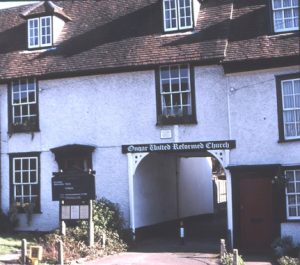
Livingstone's rooms
We associate the name of David Livingstone (1813-1873) with the vast interior of "Darkest Africa", but he also spent a few months in this quiet Essex town.
At the lower end of the main street opposite the Fire Station, there is a row of cottages with an archway leading to the United Reformed Church (CM5 9DT). Livingstone came here in 1838 as assistant to the minister, Richard Cecil, and a plaque tells us that he lived in the room above the arch prior to his great work in Africa.
EARL'S COLNE
Opposite the church is a large house called Colne Place (CO6 2RG), now a residential home for the elderly. Here in 1786 was born the philanthropist Sir Thomas Fowell Buxton, who married the sister of Elizabeth Fry. Buxton served for a time in Parliament and took on the mantle of Wilberforce, devoting all his energies to a wide range of campaigns, particularly the abolition of slavery in all its forms, until his health eventually gave way.
COGGESHALL
The village seems to consist mainly of houses about 500 years old, including the famous Paycocke's, now owned by the National Trust. The church of St Peter ad Vincula (CO6 1UD) was partly destroyed by a stray bomb in the Second World War, but has been rebuilt in the original style. Here as vicar came John Owen in 1646, a theologian of immense learning whose works are still consulted today. His name appears in the list of vicars in a side chapel. He had served at Fordham near Colchester from 1643 to 1646 and went on to become chaplain to Oliver Cromwell, preaching after the Battle of Worcester and at the funeral of Henry Ireton. From 1652 to 1658 he was Chancellor of Oxford University.
After the Restoration in 1660, Owen was offered high preferment if he would conform to the Church of England. He stuck to his nonconformist principles, but was held in such high regard that he suffered relatively few restrictions and was allowed to continue preaching.


